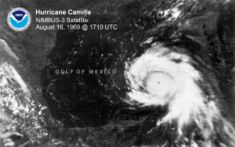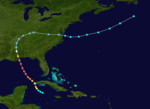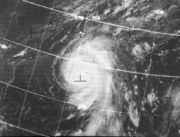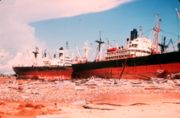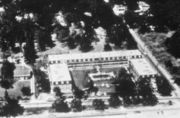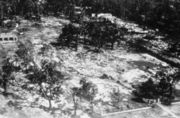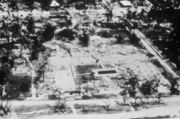Hurricane Camille
2007 Schools Wikipedia Selection. Related subjects: Storms
| Category 5 hurricane ( SSHS) | ||
|---|---|---|
|
Hurricane Camille in the Gulf of Mexico |
||
| Formed | August 14, 1969 | |
| Dissipated | August 22, 1969 | |
| Highest winds |
|
|
| Lowest pressure | 905 mbar ( hPa) | |
| Damage | $1.42 billion (1969 USD)
|
|
| Fatalities | 259 direct | |
| Areas affected |
Cuba, Alabama, Mississippi, Louisiana, Southern United States (particularly major flooding in Virginia) | |
| Part of the 1969 Atlantic hurricane season |
||
Hurricane Camille was the third tropical cyclone and second hurricane of the 1969 Atlantic hurricane season. Camille was the second of three Category 5 hurricanes to make landfall in the United States during the 20th century, which it did near the mouth of the Mississippi River on the night of August 17, resulting in catastrophic damage. Camille was the only Atlantic hurricane with official winds reported to reach at 190 mph until Allen in 1980.
The storm formed on August 14 and rapidly deepened. It scraped the western edge of Cuba at Category 3 intensity. Camille strengthened further over the Gulf of Mexico and made landfall with a pressure of 909 mbar ( hPa), estimated sustained winds of 190 mph (305 km/h), and a peak storm surge of 24 feet (7.3 m); by maximum sustained wind speeds, Camille was the strongest landfalling tropical cyclone recorded worldwide, and one of only four tropical cyclones worldwide to even reach 190 mph winds. The hurricane flattened nearly everything along the coast of the U.S. state of Mississippi, and caused additional flooding and deaths inland while crossing the Appalachian mountains of Virginia. In total, Camille killed 259 people and caused $1.42 billion (1969 USD, $9.14 billion 2005 USD) in damages.
Storm history
A tropical wave left the coast of Africa on August 5, becoming a tropical disturbance on August 9, 480 miles east of the Leeward Islands. Aircraft reconnaissance identified a closed circulation in the disturbance on the 14th near Grand Cayman and the system was designated Tropical Storm Camille with 60 mph (95 km/h) winds.
The storm already had a well organized circulation and rapidly strengthened from August 14 to August 15 to a 115 mph (185 km/h) major hurricane before hitting the western tip of Cuba later that day. Land interaction weakened Camille to a 100 mph (160 km/h) hurricane, but it returned to perfect conditions as it crossed the Gulf of Mexico (possibly while passing over the Loop Current). On August 17, Camille reached an intense minimum central pressure of 905 mbar ( hPa), and it continued to strengthen to a peak of over 190 mph (305 km/h) winds (possibly the strongest ever recorded in an Atlantic hurricane). In the hours before landfall, a reconnaissance aircraft was unable to obtain a surface wind report, but it estimated winds of up to 205 mph (335 km/h) and a minimum central pressure of 901 mbar (hPa).
Camille crossed the southeastern tip of Louisiana, and then hit near Bay St. Louis, Mississippi, on the night of August 17. Its Category 5 strength winds are only estimated, due to the lack of wind reports near the centre, though the NASA site at Stennis Space Centre, MS near Picayune, Mississippi, recorded an estimated gust of 160 mph with a pressure of 950 mbar. It maintained hurricane force winds for 10 hours as it moved 150 miles inland. As Camille turned east, it weakened to a tropical depression over northern Mississippi on the 19th. It picked up additional moisture from the Gulf Stream along the way and produced torrential rains in the remote mountains of Virginia. Camille turned eastward as it moved inland, and emerged into the Atlantic Ocean near Virginia Beach, Virginia, on the 20th. The depression restrengthened over the Gulf Stream, and briefly attained a peak of 70 mph (110 km/h) before becoming extratropical on the 22nd, east of Nova Scotia.
Impact
| Most intense landfalling U.S. hurricanes Intensity is measured solely by central pressure |
|||
|---|---|---|---|
| Rank | Hurricane | Season | Landfall pressure |
| 1 | "Labor Day" | 1935 | 892 mbar ( hPa) |
| 2 | Camille | 1969 | 909 mbar (hPa) |
| 3 | Katrina | 2005 | 920 mbar (hPa) |
| 4 | Andrew | 1992 | 922 mbar (hPa) |
| 5 | "Indianola" | 1886 | 925 mbar (hPa) |
| 6 | "Florida Keys" | 1919 | 927 mbar (hPa) |
| 7 | "Okeechobee" | 1928 | 929 mbar (hPa) |
| 8 | Donna | 1960 | 930 mbar (hPa) |
| 9 | " New Orleans" | 1915 | 931 mbar (hPa) |
| 10 | Carla | 1961 | 931 mbar (hPa) |
| Source: U.S. National Hurricane Centre | |||
Making landfall as a Category 5 hurricane, Camille caused damage and destruction across much of the Gulf Coast of the United States. Because it moved quickly through the region, Hurricane Camille dropped only moderate precipitation in most areas. Most other areas reported from 1 to 6 inches. The area of total destruction in Harrison County, Mississippi was 68 square miles (176 km²). The total estimated cost of damage was $1.42 billion (1969 USD, $9.14 billion 2005 USD). This made Camille the second-most expensive hurricane in the United States, up to that point (behind Hurricane Betsy). The storm directly killed 143 people along Alabama, Mississippi, and Louisiana. An additional 153 people perished as a result of catastrophic flooding in Nelson County, Virginia and other areas nearby. In all, 8,931 people were injured, 5,662 homes were destroyed, and 13,915 homes experienced major damage, with many of the fatalities being coastal residents who had refused to evacuate.
Gulf Coast and the Caribbean
In the only Caribbean Island greatly affected by Camille, Cuba, three deaths were reported. Over 10 inches of rain were recorded in the western portion of Cuba. But in continental North America, where Camille was stronger, more damage was brought. While moving over southeastern Louisiana, the Weather Bureau Office at Boothville reported wind gusts of 107 mph. At least $350 million (1969 USD, $1.85 billion 2005 USD) in damage was reported. Alabama also experienced damage along U.S. Highway 90. 26,000 homes and over 1,000 businesses were wiped out completely across the state. Camille's large circulation also resulted in a 3 to 5 foot storm surge in Apalachicola, Florida.
Mississippi received the worst of the damage. Upon making landfall, Camille produced a 24 foot storm surge. Mississippi's entire shore and for some three to four blocks in, the destruction was nearly complete. The worst hit areas were Clermont Harbour, Lakeshore, Waveland, Bay St. Louis, Pass Christian, Long Beach, and the beach front of Gulfport, Mississippi City, and Biloxi. More than 11 inches of rain occurred in Hancock County, Mississippi, and most low-lying areas were flooded with up to 15 feet of water. U.S. Highway 90, which is close to the shore, was broken up in many areas and sand and debris blocked much of it. Totals say that 3,800 homes and businesses were completely destroyed. As Camille came ashore, it passed over Ship Island, off the coast of Mississippi. Camille's strong storm surge and torrental rains literally split the island in two. That body of water between the east and west parts of the island is now called "Camille's Cut".
In addition, one of Frank Lloyd Wright's waterfront houses for W. L. Fuller, in Pass Christian, Mississippi, was completely destroyed by Hurricane Camille.
The Hurricane Party
One persistent legend about Camille states that a hurricane party was held on the third floor of the Richelieu Manor Apartments in Pass Christian, Mississippi, in the path of the eyewall as it made landfall. The high storm surge flooded and destroyed the building, and there was only one survivor to tell of the story of the others. Who the survivor is, how many party guests there were, and just how far the sole survivor was swept by the storm varies with the retelling.
In reality, most of the people that stayed in the Richelieu Apartments survived, but there is heavy debate on whether or not there was a party. Interviews from the local TV news station, WLOX, interviewed people who claimed to have stayed in the Richelieu Apartments. Among the survivors was the manager, who supposedly stayed in the Manager's Office while the party was going on. The wall of the office collapsed, causing water to come in. The manager claimed to have used a nearby object to stay afloat on the water until the storm receded. Though other people have claimed that the residents, exhausted from preparing the town to weather the storm, took refuge in the building not out of recklessness, but because it was believed to be one of the sturdiest buildings in the area. Survivor Ben Duckworth is quoted in Hurricane Camille: Monster Storm of the Gulf Coast as stating that the Richelieu was a designated civil defense air-raid shelter. However, their faith in the building's sturdiness was unfounded, as it was completely demolished by the storm. Twenty-three people are known to have stayed in the Richelieu Apartments during the hurricane, of whom eight died.
The tale of the lone survivor and the party appears to have originated with survivor Mary Ann Gerlach. Other survivors, including Duckworth and Richard Keller have expressed irritation at the story. "The hurricane party never happened, nor were the number of deaths associated with the apartment inhabitants accurate," says Pat Fitzpatrick, Mississippi State University professor and author of Hurricanes: A Reference Handbook.
Ohio Valley and the Virginias
Camille caused moderate rainfall in Tennessee and Kentucky of up to 5 inches, helping to relieve a drought in the area.
While moving through Virginia and West Virginia, Camille dropped torrential rainfall of 12 to 20 inches, with one unofficial report of 31 inches. Most of the rainfall occurred in Virginia during a 3-5 hour period on August 20. The flooding led to overflown rivers in the 2 states, with the highest amounting being the James River in Richmond with a peak crest of 28.6 feet. Many rivers in Virginia and West Virginia set records for peak flood stages, causing numerous mudslides along mountainsides. In the mountain slopes between Charlottesville and Lynchburg, more than 10 inches of rain fell in a course of 12 mere hours. And in the same time, Nelson County recorded 27 inches of rain. Flooding was so catastrophic that all communications were cut off from the rest of the state. Because the hurricane was expected to quickly dissipate, few were prepared for the flash flooding. The ensuing flash flood and mudslide killed 153 people. In Nelson County alone, 133 bridges were washed out, while some entire communities were under water. The major flooding that occurred downstream cut off all communications between Richmond and the Shenandoah Valley. Waynesboro on the South River saw eight feet of water downtown and Buena Vista had more than five feet. Throughout Virginia and West Virginia, Camille destroyed 349 houses, 83 trailers, 730 farm buildings, and 96 buildings. 4,128 families were affected by the hurricane in the area, and total damage amounted to $140.8 million (1969 USD, $747 million 2005 USD).
Aftermath
The response after the storm involved many federal state and local agencies and volunteer organizations. The main organization for coordinating the federal response to the disaster was the Office of Emergency Preparedness which provided $76 million (1969 USD, $403 million 2005 USD) to administer and coordinate disaster relief programs. Food and shelter were available the day after the storm. On August 19 portions of Mississippi and Louisiana were declared major disaster areas and became eligible for federal disaster relief funds.
Major organizations contributing to the relief effort included the Federal Power Commission which helped fully return power to affected areas by November 25, 1969. The Coast Guard (then under the Department of Transportation), Air Force, Army, Army Corps of Engineers, Navy and Marine Corps all helped with evacuations, search and rescue, clearing debris and distribution of food. The Department of Defense contributed $34 million (1969 USD, $180 million 2005 USD) and 16,500 military troops overall to the recovery. The Department of Health provided 4 million dollars towards medicine, vaccines and other health related needs.
Long term re-development was overseen by the Department of Commerce, which contributed $30 million (1969 USD, $159 million 2005 USD) towards planned and coordinated redevelopment of affected areas.
The devastation of Camille inspired the implementation of the Saffir-Simpson Hurricane Scale. After the storm, many Gulf Coast residents commented that hurricane warnings were not clear enough in conveying the expected intensity of the coming storm. The Saffir-Simpson scale offered a much more concise statement of storm intensity than barometric pressure and wind speed measurements, and veterans of previous hurricanes could analogize the power of the approaching storm to those they had experienced.
In a 1999 report on Hurricane Camille sponsored by the NOAA Coastal Services Centre, the authors concluded: "With Camille, the preparations for the event and the response were based on processes put in place long before the storm made landfall. Coordination between government agencies as well as with state and local officials was enhanced because of preexisting plans."
One small compensation was that recovery from flood damage in Nelson County, Virginia led to the discovery of the Ginger Gold apple in the orchards of Clyde Harvey.
Retirement
The name Camille was retired after the 1969 season due to the major destruction and death in much of the Southern United States. A replacement name was never chosen, as a new list of names was created.
Comparisons to Hurricane Katrina
Comparisons between Hurricane Katrina of the 2005 season and Camille are inevitable because of their similar strengths and nearly identical landfall locations. Before Katrina, Camille was considered to be the "benchmark" against which all Gulf Coast hurricanes were measured. Katrina was weaker than Camille at landfall but substantially larger, which led to both a broader and a larger storm surge. Katrina was described by those that experienced Camille as "much worse" - not only because of the massive storm surge, but from the fact that Katrina pounded the Mississippi coast for a longer period of time. Camille also drew part of its record storm surge from adjacent coastal waters; Lake Borgne and Lake Pontchartrain actually receded, sparing the city of New Orleans from flooding.
Some locals argue that Katrina's death toll was made higher because those who survived Camille with no flooding and little damage believed Katrina to be less of a threat, creating a false sense of security among Camille veterans. An innkeeper at the Harbour Oaks Inn, Tony Brugger, stayed at the inn and died when his inn collapsed. A popular rumor has Brugger telling a radio station during an interview that he wouldn't leave because since Camille's surge had not affected the inn, Katrina's would not either.
Records and naming
| Most intense Atlantic hurricanes Intensity is measured solely by central pressure |
|||
|---|---|---|---|
| Rank | Hurricane | Season | Min. pressure |
| 1 | Wilma | 2005 | 882 mbar ( hPa) |
| 2 | Gilbert | 1988 | 888 mbar (hPa) |
| 3 | "Labor Day" | 1935 | 892 mbar (hPa) |
| 4 | Rita | 2005 | 895 mbar (hPa) |
| 5 | Allen | 1980 | 899 mbar (hPa) |
| 6 | Katrina | 2005 | 902 mbar (hPa) |
| 7 | Camille | 1969 | 905 mbar (hPa) |
| Mitch | 1998 | 905 mbar (hPa) | |
| 9 | Ivan | 2004 | 910 mbar (hPa) |
| 10 | Janet | 1955 | 914 mbar (hPa) |
| Source: U.S. Department of Commerce | |||
Records
Camille produced the seventh lowest official barometric pressure ever recorded in the Atlantic basin, a scant 905 mbar; the only hurricane to hit the United States with a lower pressure at landfall was the Labor Day Hurricane of 1935. A reconnaissance flight indicated a pressure of 901 mbar, but this pressure was not verified, and remains unofficial pending reanalysis. The wind speed of Camille can only be approximated, as no meteorological equipment survived the extreme conditions at landfall, but Camille is estimated to have had sustained winds of 190 mph (305 km/h) at landfall, with gusts exceeding 210 mph (340 km/h). Before Hurricane Katrina in 2005, Camille likely had the highest storm surge measured in the United States, at over 24 feet (7.3 meters).
The 24-foot storm surge quoted by the Army Corps of Engineers was based on high water marks inside surviving buildings, of which there were but three. Prior to the collapse of the Richelieu Apartments, Ben Duckworth shined a flashlight down a stairwell and found the water within one step of the third-story floor; this establishes a surge height of 28 feet at that spot at that time. About 15 minutes later, the building collapsed and the evidence vanished with it.
In addition, Camille forced the Mississippi River to flow backwards for a river-distance of 125 miles (from its mouth to a point north of New Orleans). The river further backed up for an additional 120 miles, to a point north of Baton Rouge.
Naming
In 1969 the naming conventions for hurricanes were not strictly controlled as they are today. There were only three requirements: the name had to be female (male names were not used at that time), the names had to remain in alphabetical order, and the name could not have been retired. John Hope, a meteorologist at the National Hurricane Centre had a daughter who had just graduated from high school. He added her name — Camille — to the list of storm names for the year, having no way of knowing that the storm bearing her name would become infamous.
